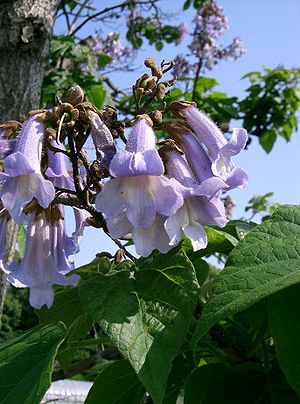
|
|
Paulownia tomentosa (flowers)
|
Paulownia - Paulownia tomentosa
Paulownia is a genus of between 6–17 species (depending on taxonomic authority) of plants in the monogeneric family Paulowniaceae, related to and sometimes included in the Scrophulariaceae. They are native to much of China, south to northern Laos and Vietnam, and long cultivated elsewhere in eastern Asia, notably in Japan and Korea. The genus, originally Pavlovnia but now usually spelled Paulownia, was named in honour of Queen Anna Pavlovna of The Netherlands (1795–1865), daughter of Tsar Paul I of Russia. It is also called "princess tree" for the same reason.
Paulownia fortunei is a fast-growing tree that is grown commercially for the production of hardwood
timber.
Paulownia tomentosa (also known as the Empress Tree, Princess Tree or Foxglove Tree; pao tong in Chinese; kiri in Japanese) is a deciduous tree in the genus Paulownia, native to central and western China, but invasive in the US. It grows to 10-25 m tall, with large heart-shaped to five-lobed leaves 15-40 cm across, arranged in opposite pairs on the stem. On young growth, the leaves may be in whorls of three and be much bigger than the leaves on more mature growth. The characteristic large size of the young growth is exploited by gardeners: by pollarding the tree and ensuring there is vigorous new growth every year, massive leaves are produced (up to 60cm across). These are popular in the modern style of gardening which uses large-foliaged and "architectural" plants.
The flowers are produced before the leaves in early spring, on panicles 10-30 cm long, with a tubular purple corolla 4-6 cm long resembling a foxglove flower. The fruit is a dry egg-shaped capsule 3-4 cm long, containing numerous tiny seeds. The seeds are winged and disperse by wind and water. Pollarded trees do not produce flowers, as these only form on mature wood.
Paulownia tomentosa can survive wildfire because the roots can regenerate new, very fast-growing stems. It is tolerant of pollution and it is not fussy about soil type. For this reason it functions ecologically as a pioneer plant. Its nitrogen-rich leaves provide good fodder and its roots prevent soil erosion. Eventually, Paulownia is succeeded by taller trees that shade it. It cannot thrive in the shade of other trees. Paulownia is extremely fast growing; some species of plantation Paulownia can be harvested for saw timber in as little as five years. Once the trees are harvested, they regenerate from their existing root systems, earning them the name of the "Phoenix tree." ("Phoenix was the mythical bird who has the ability to be reborn from its own ashes). Paulownia is being used as a reforestation tree in several countries, including Australia, Germany, China, the USA and
Panama.
Fast growing trees such as Paulownia are particularly effective for biomass production. The energy in Paulownia biomass effectively comes from the sun as the plant photosynthesizes solar energy into biomass. The tree's trunk and branches are processed into either pellets, chips or briquettes and can then be used to fuel electricity plants, just like coal.
In China, an old custom is to plant an Empress Tree when a baby girl is born. The fast-growing tree matures when she does. When she is eligible for marriage the tree is cut down and carved into wooden articles for her dowry. Carving the wood of Paulownia is an art form in Japan and China. According to both legends and records, dating back 2600 years, people in ancient times used Paulownia Trees for various purposes. In the work Zhung Tze, it is recorded "Phoenix flew from the south sea to the north sea without perching on trees other than Paulownia and without eating anything but bamboo fruit". In legend, it is said that the Phoenix will only land on the Empress Tree and only when a good ruler is in power. The Chinese have been planting Paulownia Trees for many centuries around their dwellings in order to bring good luck and to attract the
Phoenix.
Several Asian string instruments are made from P. tomentosa, including the Japanese koto and Korean gayageum zithers. Historical writings from China, recorded as far back as 1049 BC, indicate that Paulownia trees were grown in plantations for the production of high quality timber.
The soft, lightweight seeds were commonly used as a packing material by Chinese porcelain exporters in the 19th century, before the development of polystyrene packaging. Packing cases would often leak or burst open in transit and scatter the seeds along rail tracks. This, together with seeds released by specimens deliberately planted for ornament, has allowed the species to become an invasive weed tree in areas where the climate is suitable for its growth, notably Japan and the eastern United States.
Source:
http://en.wikipedia.org/wiki/Paulownia
http://en.wikipedia.org/wiki/Paulownia_tomentosa
http://www.paulowniatrees.com.au/History.htm
